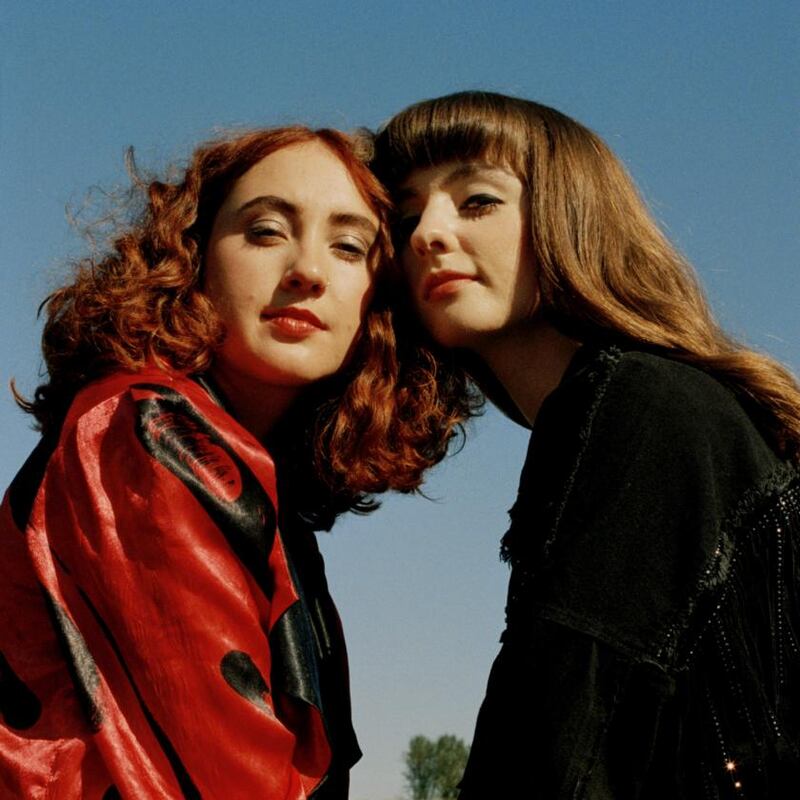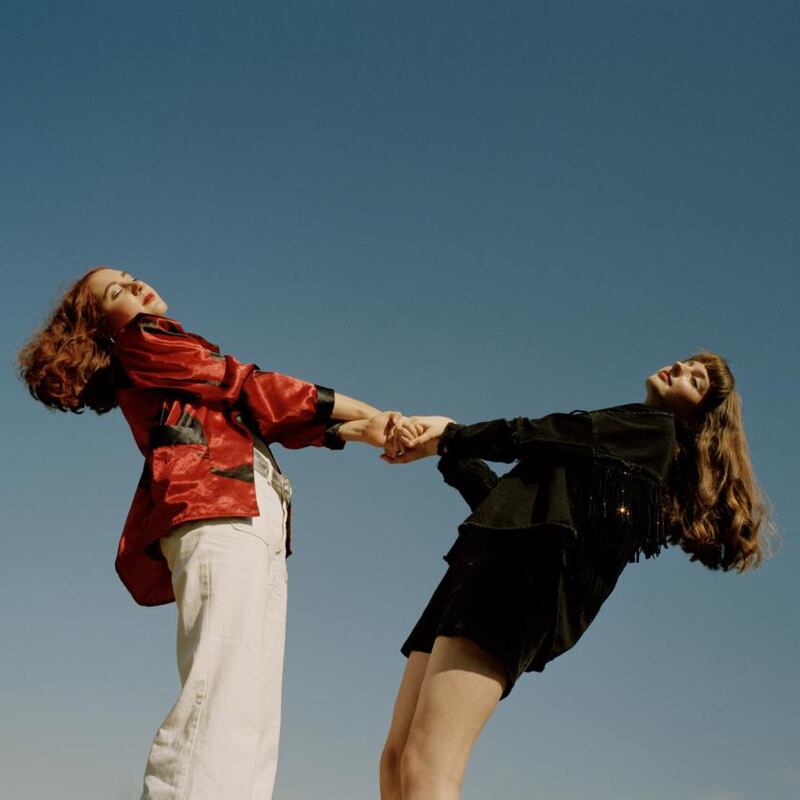To this day, whenever Let’s Eat Grandma’s Jenny Hollingworth hears a song by the Scottish electronic band Chvrches, she find herself fighting tears. It brings her back to one of the most painful and challenging times of her life: a spring 2019 tour of Ireland and the UK opening for Chvrches, which coincided with the latter stages of her boyfriend Billy Clayton’s treatment for cancer. Clayton, an up-and-coming singer-songwriter, would pass away on March 29th of that year, aged 22.
“Those Chvrches songs that they played every night bring back so many memories for me,” says Hollingworth. “Some of them really quite difficult, actually. And quite intense. It’s weird how music does that. Every night we would hear their setlist . . .”
Grief is extremely confusing. That's one of the things that isn't said enough about it
Hollingworth sings about Clayton – his life, his death, the people he left behind – on Let’s Eat Grandma’s haunting and emotionally eviscerating new record. Two Ribbons builds on the psychedelic synth-pop Hollingworth and bandmate/best friend Rosa Walton perfected across two previous albums, having started Let’s Eat Grandma as bored teenagers in Norwich. Powered by spooky beats and bruised off-centre melodic instincts, it is in part a mediation on bereavement and how to get through it. One that ultimately ends up on a place of hope and optimism. But the journey there is wrenching.
“I knew I had these songs to write,” says Hollingworth of the process of negotiating the loss of Clayton. Her first boyfriend, he had been diagnosed with Ewing’s sarcoma, a rare cancerous tumour that grows in the bones or surrounding soft tissue. He passed way at a hospital in Cambridge, two days after Hollingworth’s final visit.
“Every time I tried to write a song, it kind of boiled down to one or two words, like ‘watching you go’ [which inspired a track of the same name]. I couldn’t get rid of that lyric. Every time I tried to write a song it would just come back. It was hard. Grief is extremely confusing. That’s one of the things that isn’t said enough about it. It’s completely disorientating. Trying to make sense of it in a song was really difficult. In many ways, I think some of the songs are just expressing feeling disorientated.”
Zooming in from separate locations, Hollingworth (in Norwich) and bandmate Rosa Walton (in the London flat she shares with her boyfriend) have perfect best friend energy. It isn’t that they finish one another’s sentences – more that they seem genuinely rapt by and respectful of what the other is saying.
Yet if it’s hard to believe they would ever exchange a cross word, let alone have a serious falling out, a cooling in their relationship is another of the themes of Two Ribbons. Inseparable since childhood, as adults in their 20s they have grown apart and started to go their own ways. Which is natural. And also difficult.
“Situations change. And when you’re a band working with your best friend – that’s a recipe for lots of pressures at work,” says Walton. “There is a lot of pressure related to being in a band with someone. It [the past several years] was a really difficult time in our personal lives. With all of that, I don’t know who wouldn’t have had problems.”

Let’s Eat Grandma started when Hollingworth and Walton began experimenting with guitars, laptops and keyboards at school. After blazing a trail in Norwich, they came to the attention of London indie label Transgressive, and were soon touring with artists such as Julia Jacklin and Marika Hackman. And basking in superlative reviews, with Rolling Stone hailing the pair “indie pop dynamite” and Pitchfork praising their “kaleidoscopic production” and the way it “swirled into marvellous breathtaking songs”. They were also the best act at Electric Picnic 2019, delivering a sparkling set even as Hollingworth reckoned with her grief.
They had always thought of each other as virtual sisters. But, as they sing on the recent single Happy New Year, they’re older now and the dynamic has shifted. They’re still there for one another. And yet, things are different now.
“Nothing that was broken, can touch how much I care for you” sings Walton to Hollingworth. “Because you know you’ll always be my best friend.” But there’s a devastating counter punch from Hollingworth, who wonders, “Do you think if we’d have been together we’d be breaking up?”
“We were close from a young age,” says Walton. “We met when we were four. And from between the ages of four and up until our issues we were bound at the hair. The whole twins thing was definitely accentuated . . . for the press. But in some ways it wasn’t untrue as well. We were really, really close.”
Due to the pandemic, the recording process was different for Two Ribbons. So it was awkward when they finally got together face to face and had to reckon with the fact a lot of their lyrics were about their friendship. “Because we wrote the songs [for Two Ribbons] before we got to the studio, we weren’t there for the bits the other one was writing about,” says Walton. “Recording some of it was difficult.”

Norwich obviously isn’t the centre of the universe. It does have a thriving indie scene, though. The greater East Anglia region has a dark past, to boot, with its historical ties to Puritanism and its traditions of witch burning (East Anglia is the setting for cult horror film, Witchfinder General). Given its present-day artiness and baroque heritage, how do they feel about Steve Coogan, as Alan Partridge, portraying their hometown as a hot-bed of middle England fustiness – a land of Travelodges, roundabouts and controversial pedestrianisation?
“It would be more accurate if Steve Coogan was actually from Norwich. I actually think Norwich is quite arty,” says Hollingworth. “It’s become more like that over the years as well. Be careful what you [say], they’ll come for me. Somebody posted Norwich was ‘uncool’ in Q Magazine and they got slaughtered.”
Let’s Eat Grandma are looking forward to the release of Two Ribbons (put back because of delays in vinyl production) and to going out on tour. Still, they are grateful, too, for the time away. And for the opportunity it afforded to be alone with their emotions and to think and to heal. And while it would be trite to say the pandemic was a blessing, the lockdown was helpful – in particular to Hollingworth as she grieved and tried to unravel her thoughts (one coping mechanism was to take long walks through graveyards).
“I don’t even need to preface this and say that obviously the pandemic was awful. Even though nobody was pressurising me directly, I felt a lot of pressure to get over it [Clayton’s death], if that makes sense,” she says. “That’s how it is, I think. Because there was the pandemic, I felt there was less pressure for me to get on with my life when I was not in a good way.”

“It was good for having a time for reflection,” continues Walton. “When you’ve got nothing else and no distractions – to be able to go back to yourself and do a lot of thinking, that was beneficial. There was none of the extra pressures of the industry. It was as if we didn’t have to think of ourselves as even being in a band.”
Female friendship is one of the most potent and misunderstood quality in arts. Lately, there has been a upsurge in female duos – see also Wet Leg and Lucius – and in each case much of the creative dynamic flows from the relationship between the two women at the centre. This feels like an overdue correction to decades of lionising the idea of the rock band – from the Beatles to Oasis – as a collection of lads against the world.
But the energy produced by two women in musical harmony is also something that people can find unsettling, even creepy. It’s as if we can’t see women of similar age and fashion sensibility side by side on stage without freaking out slightly. Or so Hollingworth and Walton noticed when they started playing together.
“We used to sit and stare at the audience a lot,” says Walton. “A lot of people interpreted that as creepy. We’d get a lot of comparisons to the twins from The Shining. I don’t think we recognised it as being creepy. We recognised the power of standing and staring at the audience and looking exactly the same.”
Being creepy and horrific is almost like a way of reclaiming power over the audience and over your own self
“There seems to be this common thing in horror of teenage girls and their bonds with each other,” says Hollingworth. “Especially with sisters. And them growing into adults – and how that’s kind of a bit monstrous. And really confusing to people. It gives you a bit of power, I think.”
That sense of empowerment was essential as they navigated occasionally bizarre encounters with audience members after shows.
“Some people were weird to us because we were teenage girls,” says Walton. “Either they looked down on us. Or there was some quite inappropriate and weird behaviour when we were about 15. Being creepy and horrific is almost like a way of reclaiming power over the audience and over your own self.”
Two Ribbons is released on April 29th













